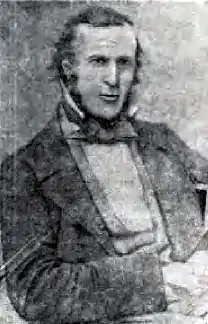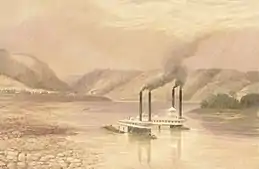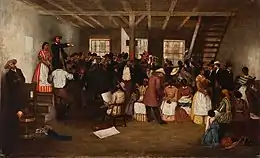Lefevre James Cranstone
Lefevre James Cranstone (March 6, 1822 – June 22, 1893) was an English artist known for his watercolor genre-style landscapes and oil paintings. He visited the United States, where many of his works are displayed, and later moved to Australia.
Lefevre James Cranstone | |
|---|---|
 Photograph of Lefevre James Cranstone, c.1859 | |
| Born | March 6, 1822 Hemel Hempstead, UK |
| Died | June 22, 1893 (aged 71) Brisbane, Australia |
| Resting place | Toowong Cemetery, Brisbane |
| Nationality | British |
| Alma mater |
|
| Known for | Landscape paintings and sketches |
| Movement | Genre art |
| Spouse(s) | Lillia Messenger |
Early life
Cranstone was the second of thirteen children born in Hemel Hempstead, England to Joseph, Jr. and Maria Lefevre Cranstone. In 1838 he enrolled in Henry Sass's School of Art in London and at age 18 was received as a probationer into the Royal Academy School on April 21, 1840. Following his formal training he exhibited a number of oil paintings in the annual exhibitions of the Royal Society of British Artists in Suffolk Street and at the Royal Academy. In addition to his watercolor and oil paintings, during his lifetime Cranstone also produced etchings and pen and ink and chalk drawings. He was also an art teacher in his wife Lillia's boarding school.
Works


Despite exhibiting at prestigious institutions such as the Royal Academy, Cranstone did not achieve popular recognition in Britain, and he is best known for his prolific work in America. For a ten-month period in 1859 and 1860 Cranstone, with his younger brother Alfred, visited cousins in Virginia and Indiana. During this trip he prepared almost 300 pen and ink with wash sketches documenting both the rural and urban areas of antebellum America which they visited. Works include paintings of the Ohio River at Wheeling, West Virginia, the White House in Washington DC and the Courthouse in Colonial Williamsburg. [1]
Sketches he made during his American visit became available for sale in 1928 and are in the collections of the Lilly Library at Indiana University in Bloomington.[2] In 1933 a collection of 98 larger watercolor versions of a representative number of the sketches were sold at auction. One of these was the oil painting, Slave Auction, Virginia, which hangs in the Virginia Museum of History & Culture in Richmond, Virginia.[3][4] Donald L. Smith's biography of Cranstone contains a facsimile of this painting along with a letter dated December 29, 1860, that Cranstone wrote to the Hemel Hempstead Gazette, stating his views on the election of Abraham Lincoln as President of the United States, denouncing the brutality of slavery and describing in detail the horrors of a slave auction in Richmond, Virginia.[5]
Cranstone's paintings are in the art collections of the White House;[6] the Metropolitan Museum of Art;[7] the Museum of Fine Arts, Boston;[8] the Virginia Historical Society; the Virginia Museum of Fine Arts; the Colonial Williamsburg Foundation; the Oglebay Institute Mansion Museum in Wheeling, West Virginia; the Dacorum Heritage Trust in Berkhamsted, England;[9] and other institutions and private collections. An art collection he prepared in Australia, along with a volume of illustrated poetry verse brought with him from England, are at the John Oxley Library in Brisbane.[10]
Later life
On July 12, 1882 Cranstone's wife, Lillia, died. Shortly afterwards, Cranstone and two of his children, Beatrice Lillia and Frederic George, joined his third son, William, now a medical doctor, and his new wife, Ellen Kent, in moving to the small town of Clermont, Queensland, Australia. Here, Cranstone continued his paintings of the local land and seascapes. In 1889 he moved with Beatrice to Brisbane where he continued drawing local subjects up to his death on June 22, 1893.
References
- "Lefevre Cranstone". www.dacorumheritage.org.uk. Dacorum Heritage Trust. Archived from the original on 10 May 2018. Retrieved 10 May 2018.
- "Cranstone Sketches Mss". Lilly Library. Retrieved 18 September 2015.
- "Painting, "Slave Auction, Virginia"". Virginia Museum of History & Culture | ARGUS.net (final). Retrieved 19 August 2020.
- History, Virginia Museum of; Richmond, Culture 428 N. Arthur Ashe Boulevard; Box 7311, Virginia 23220 Mail: P. O. (24 March 2013). "Slave Auction, Virginia, by LeFevre Cranstone, c. 1860s". Virginia Museum of History & Culture. Retrieved 19 August 2020.
- Smith 2004, pp. 85-88, 131-135.
- "Asset Bank - Search Results". The White House Historical Association. Retrieved 18 September 2015.
- "Lefevre James Cranstone". The Metropolitan Museum of Art. New York, USA. Retrieved 18 September 2015.
- "Lefevre James Cranstone". Museum of Fine Arts, Boston. Retrieved 18 September 2015.
- "New Civic Centre display puts the spotlight on creative artists of Dacorum's past". Berkhamsted & Tring Gazette. 29 September 2013. Archived from the original on 10 May 2018. Retrieved 10 May 2018.
- "Lefevre James Cranstone 1822?-1893". State Library of Queensland. Retrieved 18 September 2015.
Further reading
- Buteux, Elizabeth. Lefevre James Cranstone: A Victorian Quaker Artist, Berkhamsted, England: Dacorum Heritage Trust, 2007. ISBN 978-0953941445.
- Smith, Donald L. (2004). Lefevre James Cranstone: His Life and Art. Richmond, Virginia: Brandylane Publishers Inc. ISBN 978-1-883911-60-7. Retrieved 19 August 2020.CS1 maint: ref=harv (link)
- Smith, Donald L. Illustrated Poetry Verse by Lefevre James Cranstone (1822-1893), Williamsburg, Virginia: Historic Research Services, 2007. ISBN 978-0615179469.
External links
| Wikimedia Commons has media related to Lefevre James Cranstone. |
- 2 paintings by or after Lefevre James Cranstone at the Art UK site
- "Lefevre James Cranstone (1822 – 1893)". AMERICAN GALLERY - 19th Century. 19 January 2017. Archived from the original on 10 May 2018. Retrieved 10 May 2018.
- "Richmond, Indiana, Seventh Street" (1860), watercolor painting in the collections of the Indiana Historical Society, Indianapolis
- "Lefevre J. Cranstone Watercolor Paintings, ca. 1861" collection guide, Indiana Historical Society, Indianapolis